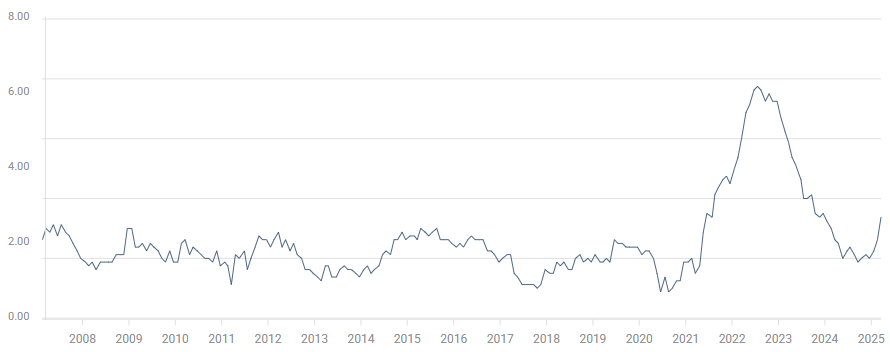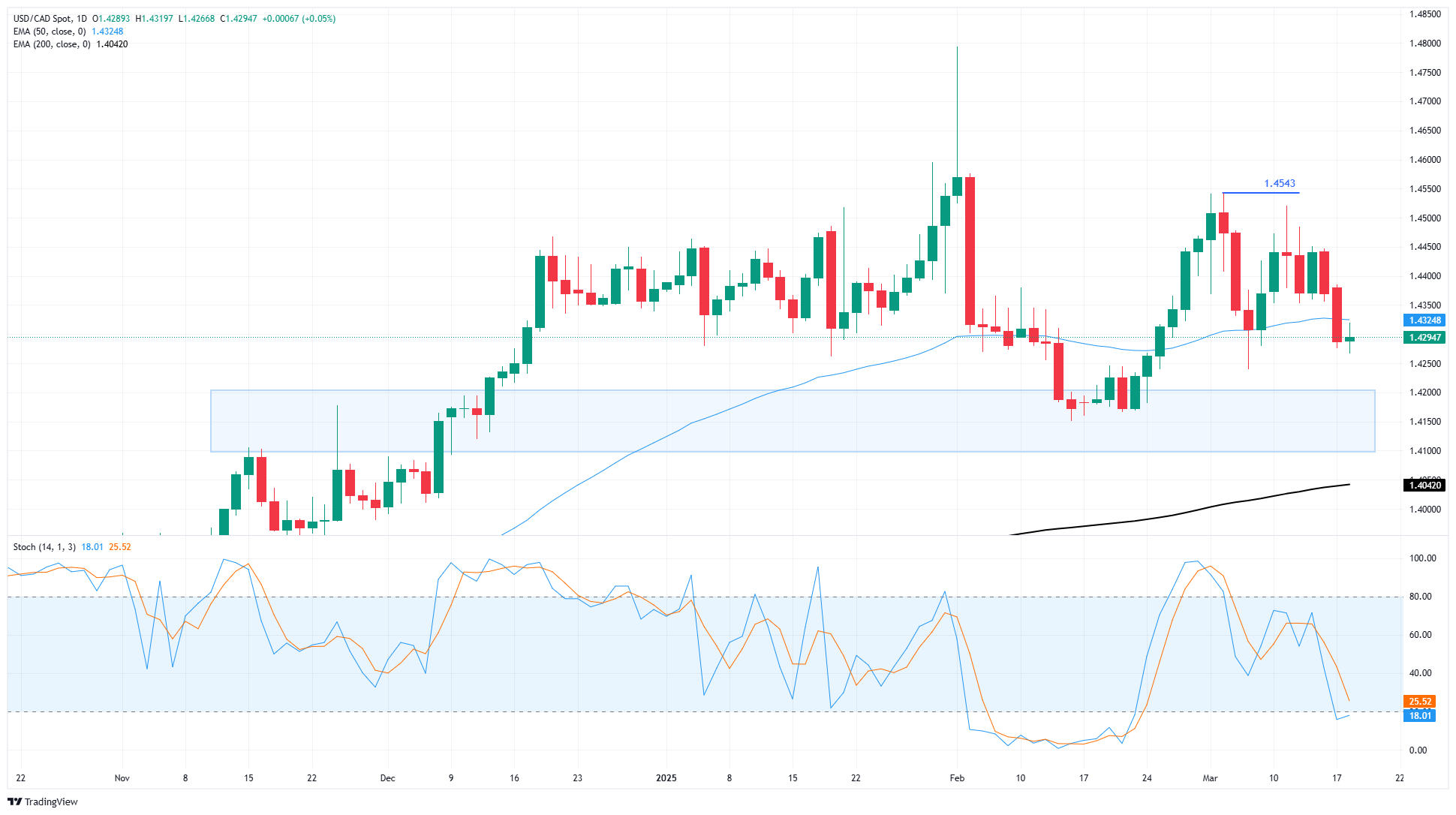- Analytics
- News and Tools
- Market News
- Canadian Dollar twists near 1.43 as Canadian inflation accelerates
Canadian Dollar twists near 1.43 as Canadian inflation accelerates
- The Canadian Dollar churned chart paper near 1.43 on Tuesday.
- Canadian CPI inflation accelerated faster than expected in February.
- Despite the inflation uptick, the Loonie is holding steady as BoC rate cut bets ease.
The Canadian Dollar (CAD) found a foothold against the US Dollar (USD) on Tuesday, cycling near the 1.4300 handle after Canadian Consumer Price Index (CPI) inflation accelerated even faster than expected in February. Despite inflation once again rearing its head in Canadian data, the Loonie found some market support as the CPI upswing diminishes odds of further rate cuts from the Bank of Canada (BoC).
The BoC’s latest rate cut last week is proving to be just as poorly-timed as most market participants expected. Inflation pressures are back above the Canadian central bank’s 2% annualized inflation target, and showing serious signs of accelerating. The BoC has cut interest rates seven times since H2 2024, presumably in an effort to try and tamp down on runaway housing prices, a truly bizarre strategy in a country where the majority of mortgage rates are tied to Canadian bond yields rather than directly correlated to interest rates.
As the BoC slashes rates while tumbling straight down a fresh inflation hole, markets already rattled by a growing trade war between Canada and the US have pushed bond yields even higher as investors struggle to understand what BoC Governor Tiff Macklem is trying to accomplish. The BoC now finds itself in the unenviable position of having few rate cuts left in the powder bag to bolster the Canadian economy should the economy continue to take a turn for the worse, alongside high inflation and still-too-hot housing costs to contend with.
BoC Consumer Price Index Core (YoY) 
Daily digest market movers: Canadian Dollar holds steady after markets call inflation uptick
- Canadian Dollar holds steady near key 1.4300 level against Greenback on Tuesday.
- Headline Canadian CPI inflation accelerated to 2.6% YoY in February, well above the median market forecast of 2.1% and rising sharply from the previous period’s 1.9%.
- The BoC’s own core CPI inflation metric also accelerated, bounding to 2.7% YoY from 2.1%.
- Market bets of another BoC rate cut at the Canadian central bank’s next rate call have withered in the face of a new round of inflation pressures within the Canadian economy. Rate swaps now see a 30% chance of yet another quarter-point cut in April, down from 45% pre-CPI data.
- Canadian economic data remains limited through the remainder of the trading week, however mid-tier Canadian Retail Sales are slated for Friday.
Canadian Dollar price forecast
The Canadian Dollar’s stubborn hold near the 1.4300 handle against the Greenback has left the USD/CAD pair strung out near the low end of a too-familiar lateral channel. The pair continues to churn near the 50-day Exponential Moving Average (EMA) as a long-term trend remains absent.
The immediate challenge for a continued leg higher for the Loonie will be a hefty supply zone priced in on USD/CAD between 1.4200 and 1.4100.
USD/CAD daily chart
Canadian Dollar FAQs
The key factors driving the Canadian Dollar (CAD) are the level of interest rates set by the Bank of Canada (BoC), the price of Oil, Canada’s largest export, the health of its economy, inflation and the Trade Balance, which is the difference between the value of Canada’s exports versus its imports. Other factors include market sentiment – whether investors are taking on more risky assets (risk-on) or seeking safe-havens (risk-off) – with risk-on being CAD-positive. As its largest trading partner, the health of the US economy is also a key factor influencing the Canadian Dollar.
The Bank of Canada (BoC) has a significant influence on the Canadian Dollar by setting the level of interest rates that banks can lend to one another. This influences the level of interest rates for everyone. The main goal of the BoC is to maintain inflation at 1-3% by adjusting interest rates up or down. Relatively higher interest rates tend to be positive for the CAD. The Bank of Canada can also use quantitative easing and tightening to influence credit conditions, with the former CAD-negative and the latter CAD-positive.
The price of Oil is a key factor impacting the value of the Canadian Dollar. Petroleum is Canada’s biggest export, so Oil price tends to have an immediate impact on the CAD value. Generally, if Oil price rises CAD also goes up, as aggregate demand for the currency increases. The opposite is the case if the price of Oil falls. Higher Oil prices also tend to result in a greater likelihood of a positive Trade Balance, which is also supportive of the CAD.
While inflation had always traditionally been thought of as a negative factor for a currency since it lowers the value of money, the opposite has actually been the case in modern times with the relaxation of cross-border capital controls. Higher inflation tends to lead central banks to put up interest rates which attracts more capital inflows from global investors seeking a lucrative place to keep their money. This increases demand for the local currency, which in Canada’s case is the Canadian Dollar.
Macroeconomic data releases gauge the health of the economy and can have an impact on the Canadian Dollar. Indicators such as GDP, Manufacturing and Services PMIs, employment, and consumer sentiment surveys can all influence the direction of the CAD. A strong economy is good for the Canadian Dollar. Not only does it attract more foreign investment but it may encourage the Bank of Canada to put up interest rates, leading to a stronger currency. If economic data is weak, however, the CAD is likely to fall.
© 2000-2025. All rights reserved.
This site is managed by Teletrade D.J. LLC 2351 LLC 2022 (Euro House, Richmond Hill Road, Kingstown, VC0100, St. Vincent and the Grenadines).
The information on this website is for informational purposes only and does not constitute any investment advice.
The company does not serve or provide services to customers who are residents of the US, Canada, Iran, The Democratic People's Republic of Korea, Yemen and FATF blacklisted countries.
Making transactions on financial markets with marginal financial instruments opens up wide possibilities and allows investors who are willing to take risks to earn high profits, carrying a potentially high risk of losses at the same time. Therefore you should responsibly approach the issue of choosing the appropriate investment strategy, taking the available resources into account, before starting trading.
Use of the information: full or partial use of materials from this website must always be referenced to TeleTrade as the source of information. Use of the materials on the Internet must be accompanied by a hyperlink to teletrade.org. Automatic import of materials and information from this website is prohibited.
Please contact our PR department if you have any questions or need assistance at pr@teletrade.global.















